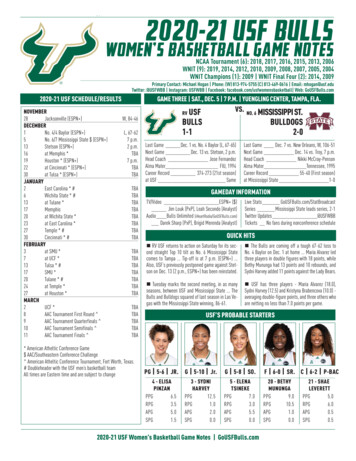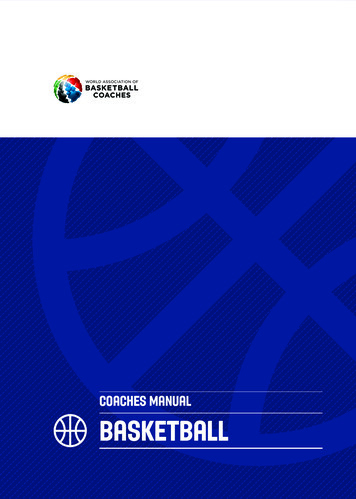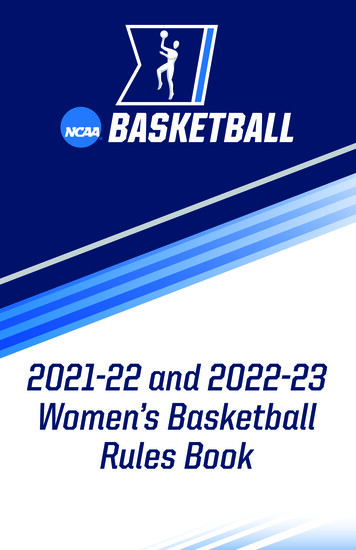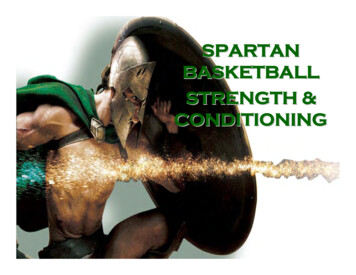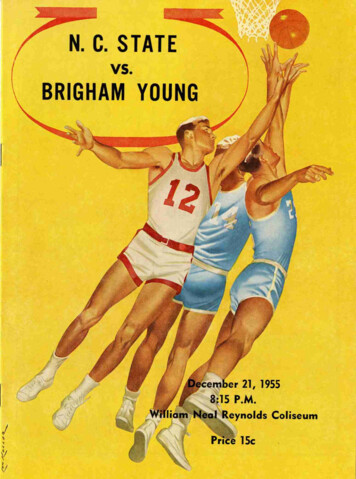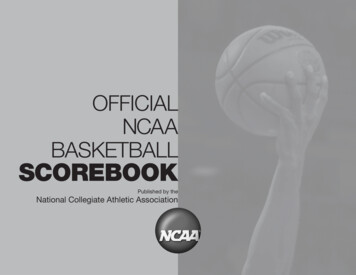
Transcription
OFFICIALNCAABASKETBALLSCOREBOOKPublished by theNational Collegiate Athletic Association
The OfficialNational Collegiate Athletic AssociationBasketball ScorebookApproved by the National Association of Basketball CoachesContemporary Format with Scoring Space for 40 Games/Official Scoring Rules and Instructions for ScoringProduced and Distributed byNCAA PUBLISHINGP.O. Box 6222, Indianapolis, Indiana, 46206-6222http://www.ncaa.orgNCAA 57711-10/06
How to use the Official NCAA Basketball Scorebook(Refer also to the Official Scoring Rules and sample Scoring Sheet)The Official NCAA Basketball Scorebook is published and distributed by theNCAA to provide coaches and officials with a uniform, official scorebook. Its useas the only official scoring form, especially for all collegiate games, willstandardize basketball scoring and assure a proper and complete record of allgames played, whether home or away.The form includes all statistical columns along with the running score for which theofficial scorer is responsible, as stated in the official NCAA Men’s and Women’sBasketball Rules and Interpretations. Actual player statistics that are commonlyrecorded—such as field-goal attempts, rebounds and assists—should be handledby a separate individual or statistical crew and not by the official scorer.GENERAL INFORMATION: The top boxes across both scoring pages givegeneral information about the game being scored, including the teams involvedand their coaches, the date, site and attendance, and the names of the officialsinvolved in the contest.SCORING BY PERIODS: In the boxes provided, record the number of points actuallyscored in each period of play. Only the final score should be cumulative, as the runningscore gives cumulative totals at the end of each period. A suggested method for scoringis to use a different ink color for each half and each overtime period.NUMBER AND PLAYER COLUMNS: Before the start of the game, the last nameand number of each squad member dressed for and eligible to play in the gameshould be recorded in the appropriate spaces. It is recommended in the official NCAArules book that the squad members’ names be entered in the scorebook in numericalorder. Space is provided at the top of the roster for an official from each team(preferably a coach) to initial the approval of the roster before the game begins.FOULS: Each time a personal foul or direct technical foul is charged to a player,make a slash through the next available number (1, 2, etc.) to keep a correct totalof the number of fouls charged to each player. Some scorers differentiate secondhalf fouls from first-half fouls by making the slash in the opposite direction duringthe second half and extra periods. You may want to indicate a technical foul with a“T” or an intentional foul with an “I.” Indicate technical fouls in the space labeled“Technicals & Notes,” noting whether they are direct or indirect.FIELD GOALS: After each successful field goal by a player, mark a “2” or “3” inthe field-goal column beside the name. Mark a “3” only if the shot is successfulfrom beyond the three-point field goal line and is indicated as such by an official.Second-half and overtime goals should be recorded in the spaces provided andnot continued in the first-half column.FREE THROWS: Record each free throw attempted and made in the proper halfor overtime space. Free-throw attempts should be recorded with abefore thefree throw is attempted. If the free throw is successful, put an X inside the .Indicate two-shot fouls by recordingand three-shot fouls by. Indicatebonus-situation fouls bybefore the shot is attempted, and byif the firstshot is successful, and byif both shots are successful. If the second shot isunsuccessful, leave the marking as.OFFICIAL SUMMARY COLUMNS: At the end of the game, the figures recordedfor each player should be totaled and placed in the proper column in the officialsummary area. Totals should be recorded for total field goals made, three-pointfield goals made, free throws made, free throws attempted, personal fouls andtotal points. Both two- and three-point field goal totals should be included in thetotal number of field goals made.TOTALS LINE BENEATH SCORING AREA: Vertically total the field goals, threepoint field goals and free throws for each half and enter on the totals line to checkfigures above with running score below.TEAM FOULS: Mark off each personal, unsporting technical or contact technicalfoul charged to each team to determine bonus free-throw situations. Indicate thetime of the foul or the players’ jersey number who committed the foul in the spaceprovided. After the sixth foul has been recorded in a half (in a college basketballgame), each succeeding common foul (except a player-control or team-controlfoul) in that half will receive a bonus free throw. Starting with the 10th team foul,each common foul (except a player-control or team-control foul) in that half shallresult in two free throws (except for a three-shot foul).TIMEOUTS: Mark each timeout charged to a team, and use the space below toindicate the time at which it was taken (from the game clock) to help substantiatethe number recorded. Some scorers also record in this space the number of theplayer who called the timeout. Use the extra blank spaces to record timeoutsin overtime games. Use the space provided on the lower-right side of the righthand pages to record each timeout called specifically for or used by broadcastmedia. Keep in mind that the number of team timeouts allowed depends onwhether the game involves commercial electronic media. For more description,see the timeout chart at the end of the rules section.TECHNICALS & NOTES: This is the official scorer’s “free” space and may beused for the recording of any pertinent data relative to the game being played forwhich space is not otherwise provided. An example of this type of information is afoul charged to a coach, other bench personnel, a follower, a player ejected forfighting, or an injured player.RUNNING SCORE: The running score is among the most important tasks of theofficial scorer, because it represents the actual game score as the gameprogresses and is the official score of the game at any point in time. Mark out thecorrect numbered squares as each point is scored. The optional spaces belowmay be used to indicate the number of the player scoring and the approximatetime remaining in the half when the points were scored.ALTERNATE POSSESSION: This space is used to keep track of teampossession when a “held ball” situation occurs. Actual center jumps are used onlyto start the contest and to start each overtime period. The alternate-possessionrule is used at every other occasion, making it important for scorers to recordeach change of possession in the space provided. Note: Space is provided toindicate the time at which a change of possession occurs.The NCAA publishes a complete manual for the basketball statistician, theBasketball Statisticians’ Manual, which is available for 5 from NCAA Publishing,phone: 888/388-9748; www.ncaa.org.
Official Scoring and Timeout Rules(Reprinted from the NCAA Men’s and Women’s Basketball Rules and Interpretations)Section 12. Duties of ScorersThe scorers shall:Art. 1. Record the names and uniform numbers of squad members who mayparticipate and those of the starting five players.Art. 2. Record the field goals made and the free throws made and missed, and keepa running summary of the points scored.Art. 3. Record the personal and technical fouls called on each player and thetechnical fouls called on a coach, squad member, bench personnel or follower.Art. 4. Notify an official immediately when the fifth foul, including any combinationof personal fouls, direct technical fouls, intentional personal fouls and (men)intentional technical fouls; or the third technical foul is charged to a squad memberor bench personnel.A.R. 29. B1 commits a fifth foul [any combination of personal fouls, direct technical fouls, and(men) intentional technical fouls], which results in two free throws for A1. The official scorer andofficial timer fail to notify any of the game officials that a fifth foul has been committed. When thescorers realize the mistake, they inform the official timer to sound the game-clock horn. The officialtimer sounds the device as the first free throw is made or missed. The referee asks the scorers’ tablepersonnel to explain the problem. The referee is advised that B1 has committed five fouls, afterwhich the referee advises the coach and player of Team B that B1 has five fouls. The coach replacesB1. Shall any free throws be awarded to Team A? RULING: No. This is a bookkeeping mistake forwhich B1 shall not be held responsible; no penalty shall be assessed.A.R. 30. A player who has committed a fifth foul (any combination of personal fouls, directtechnical fouls and (men) intentional technical fouls) continues to play because the scorers havefailed to notify the officials. RULING: As soon as the scorers discover the irregularity, they shouldsound the game-clock horn after (or as soon as) the ball is in control of the offending team or isdead. The disqualified player shall be removed immediately. Any points that may have been scoredwhile such a player was illegally in the game shall count. When other aspects of the error arecorrectable, such as permitting the wrong player to attempt a free throw, see Rule 2-11.Art. 5. Notify an official immediately when a second direct technical foul is chargedto a coach, squad member or any bench personnel.Art. 6. (Men) Notify an official immediately when two intentional technical fouls ora combination of one intentional technical foul and one direct technical foul havebeen assessed to a squad member.Art. 7. Notify an official immediately when a combination of any three technicalfouls has been assessed or when three bench direct technical fouls have been calledon a team.Art. 8. Record any ejection for fighting.Art. 9. Record the timeouts charged to each team and notify a team and its headcoach, through an official, when such team takes its final allowable charged timeout.Art. 10. Signal the nearest official each time a team is granted a charged timeout inexcess of the allowable number.Art. 11. Signal the nearest official in each half when a player commits a commonfoul (except a player-control or team-control foul), beginning with the team’sseventh foul and the team’s 10th foul, including any combination of personal fouls,direct technical fouls, (men) intentional technical fouls and flagrant technical fouls.Art. 12. Designate that the scorebook of the home team shall be the officialscorebook, unless the referee rules otherwise. The official scorebook shall remain atthe scorers’ table throughout the game, including all intermissions.A.R. 31. At halftime, the official scorer, who is a member of the home-team faculty, removes thescorebook from the scorers’ table: (a) of his or her own volition; or (b) at the request of the hometeam coach. RULING: In (a), when the removal is inadvertent and momentary, there should be nopenalty. When there is evidence that the official scorer removed the scorebook to take it to the hometeam locker room, an indirect technical foul shall be assessed to the head coach. In (b), when thehome-team coach instructs the official scorer to remove the scorebook, the head coach shall beassessed a direct technical foul. The indirect technical foul charged in (a) does not count toward thecoach’s ejection.Art. 13. Compare their records after each goal, each foul and each charged timeout,notifying the referee at once of any discrepancy. When no error can be found, thereferee shall accept the record of the official scorebook, unless the referee hasknowledge that permits another decision. When the discrepancy is in the score andthe error is not resolved, the referee shall accept the progressive team totals of theofficial scorebook.Art. 14. Correct a scoring or bookkeeping mistake any time before the refereeapproves the final score.A.R. 32. The official scorer fails to record two points awarded to Team A by an official during thefirst half as a result of basket interference by B2. RULING: The bookkeeping mistake shall berectified.A.R. 33. After two minutes of the first extra period, it is discovered that during the second half ofregulation play, the official scorer failed to record one point as a result of a made free throw by TeamA. RULING: The score shall be recorded and play shall be continued at a designated spot from thepoint of interruption.Art. 15. Keep a record in the scorebook of the names and uniform numbers ofplayers who are to start the game and of all substitutes who enter the game.a. It is recommended that squad members’ names be entered in the scorebookin numerical order.Art. 16. Notify the nearest official when there is an infraction of the rules pertainingto submission of the roster, substitutions or uniform numbers of players.Art. 17. When necessary, signal the officials with a sounding device unlike that usedby the referee and umpire(s). This sounding device may be used immediately when(or as soon as) the ball is dead or is in control of the offending team.A.R. 34. When may a scorer signal? RULING: When the scorer desires to call attention to a playerwho is illegally in the game, the scorer may signal the official when the ball is in control of thatplayer’s team or when the ball becomes dead. When it is for a substitution, the scorer may signalwhen the ball next becomes dead and the clock is stopped. When it is for conferring with an official,the scorer may signal when the ball is dead. When the scorer signals while the ball is live, the officialshall ignore the signal when a scoring play is in progress. Otherwise, the official may signal for thegame clock to be stopped to determine the reason for the signal.A.R. 35. The game-clock horn sounds while the ball is live. RULING: Players should ignore thegame-clock horn since it does not cause a dead ball. The officials shall use their judgment in blowingthe ball dead to consult with the scorers and timers. When the players on both teams do not ignorethe game-clock horn and stop playing, the officials shall award the ball to the team in control at adesignated spot nearest to where the dead ball occurred.
Art. 18. When a correctable error is called to the official scorer’s attention by a coachwhile the game clock is running, the timer shall not use the game-clock horn untilthe ball has become dead.Art. 19. For ease of identifying the official scorer, one of the following shall beplaced on the floor in front of the individual’s spot at the scorers’ table:a. An “X” composed of 12-inch line segments that are 2 inches in width.b. An NCAA logo that is a minimum of approximately 8 inches in diameter.c. An NCAA Basketball logo that is a rectangle approximately 1-1/2 feet by 21/2 feet.Note: It is recommended that only the person at the scorers’ table permitted to wear a black-andwhite-striped garment be the official scorer and that he or she be seated next to the official timer.Section 11. Charged TimeoutsArt. 1. Time shall be out and the game clock and shot clock, if running, shall bestopped when:a. A player or head coach requests a timeout, such request being granted onlywhen the player’s/coach’s team is in possession of the ball (this includesthat team’s throw-ins and its free throws) or when the ball is dead.b. An injured player or a player who is bleeding or has a uniform that issaturated with blood has that condition remedied and is permitted toremain in the game.A.R. 127. Both teams remain in their huddles after a timeout even though the official administeringthe throw-in has alerted them that play shall resume. (a) Before or (b) after the ball is placed at thedesignated spot, Team A or Team B indicates it desires a timeout. RULING: In (a), either team mayrequest and be granted a timeout. In (b), only the team entitled to the throw-in shall be granted atimeout after the throw-in count has started.Art. 2. A timeout shall not be granted until after the jump ball that begins the gameand the conditions as described in Rule 5-9 are in effect.Art. 3. In games not involving electronic media and also those with typed Internetcoverage but without audio or video broadcast, the timeout format shall be:a. Four 75-second timeouts and two 30-second timeouts for each team perregulation game.b. The four 75-second timeouts may be used at any time.c. The two 30-second timeouts may be used at any time.d. A player or a coach from the same team may request successive 30-secondtimeouts.g. Bands/amplified music are permitted to play or be played only duringany timeout or intermission.Art. 4. In games involving electronic media (i.e., radio, television, or Internet audioor visual broadcast), when the electronic-media format calls for at least threeelectronic-media timeouts in either half, the following shall be in effect:(TELEVISION, RADIO OR INTERNET AUDIO OR VISUAL BROADCAST MUSTBE PRESENT TO USE THIS ELECTRONIC-MEDIA TIMEOUT FORMAT.)a. When television is employed, there shall be four electronic-media timeoutsin each half. These electronic-media timeouts shall occur at the first deadball after the 16-, 12-, 8- and 4-minute marks when the game clock isstopped.1. The first timeout requested by either team in the second half shallbecome the length of a timeout called for by the electronic-mediaagreement.2. When the first timeout requested by either team in the second half isgranted and creates the first dead ball after one of the 16-, 12-, 8- or 4minute marks, the electronic-media timeouts for those specified timesshall occur after the next dead ball.Note: For NCAA Division I tournament games, the men’s or women’sDivision I basketball committee may make the first team-called timeout inboth halves an electronic-media timeout.b. When radio or Internet audio or visual broadcast is being used, electronicmedia timeouts shall occur at the first dead ball after the 16-, 12-, 8- and 4minute marks or after the 15-, 10- and 5-minute marks, when the game clockis stopped, depending on the electronic-media agreement.1. The first timeout requested by either team in the second half shall be 75seconds long or longer when called for by the electronic-media agreement.c.d.e.1. When successive timeouts are granted, players are permitted to sit ontheir bench only when the request has been made in advance.2. When successive 30-second timeouts are granted, a warning signalshall be sounded 15 seconds before the expiration of the final 30second timeout.e. When there is an extra period(s), each team shall be entitled to one extra 75second timeout per extra period in addition to any timeouts it has not usedpreviously.1. The extra timeout shall not be granted until after the ball becomes liveto begin the extra period(s).f. Cheerleaders and mascots are permitted on the playing court only during afull timeout or an intermission.f.2. When the electronic-media agreement calls for fewer than threeelectronic-media timeouts in one half, these electronic-media timeoutsshall occur at the first dead ball after the minute marks specified bythe electronic-media agreement.Each team shall be entitled to four timeouts, 30 seconds each in length.Each team may carry up to three 30-second timeouts into the second half.Each team shall be entitled to one 60-second timeout that may be used anytime during the game.1. No conference shall be permitted to extend the 60-second timeout byelectronic-media agreement in electronic-media games.A player or a coach from the same team may request successive 30-secondtimeouts.1. When these successive timeouts are granted, players shall be allowedto sit on their bench only when the request has been made in advance.2. When successive 30-second timeouts are granted, a warning hornshall be sounded 15 seconds before the expiration of the final 30second timeout.g. Unused 30-second team timeouts from the second half may be used in extraperiod(s).
h. A team-called 30-second timeout or a 60-second timeout (excluding the firsttimeout of the second half that becomes an electronic-media timeout) in agame involving electronic media can be shortened when the captain/coachnotifies the official of the team’s intent to do so.1. When a request has been made to shorten a timeout for a purposeother than a substitution(s), a warning signal shall be soundedimmediately and 15 seconds later a game-clock horn shall be soundedto resume play.2. When a request is made to shorten any timeout for a substitution(s),the signal for shortening a timeout shall be given and play shall beresumed immediately.i. Each team shall be entitled to one additional 30-second timeout during eachextra period.1. The extra timeout shall not be granted until after the jump ball thatbegins the extra period and the conditions as described in Rule 5-9 arein effect.2. The first timeout requested in any extra period may become anelectronic-media timeout when called for by the electronic-mediaagreement.j. Cheerleaders and mascots are permitted onto the playing court only duringan electronic-media timeout or intermission.k. Bands and amplified music are permitted to play or be played only duringany timeout or intermission.Note: (men) For Division II Men’s NCAA tournament games, the formatdescribed in Rule 5-10.4 may be used without the presence of electronic media.Art. 5. When the electronic-media agreement calls for fewer than three electronicmedia timeouts in one half, the format shall be as follows:a. Four 75-second timeouts and two 30-second timeouts for each team perregulation game.b. The four 75-second timeouts can be used at any time.c. The two 30-second timeouts can be used at any time.d. When there is an extra period(s), each team is entitled to one extra 75-secondtimeout per extra period in addition to any timeouts it has not usedpreviously.e. When the electronic-media agreement calls for either two or one timeout(s)in either half, those timeouts shall occur at the first dead ball after theminute mark specified in the electronic-media agreement. When either ofthe teams uses a 75-second timeout(s) in either the first or second half, thattimeout shall replace the next agreed-upon electronic-media timeout(s) forthat half.Art. 6. In games involving electronic media, when a foul (personal or technical) iscommitted that causes the ball to become dead at one of the specified time marks onthe game clock for electronic-media timeouts, that electronic media timeout shall betaken and then the free throw(s) shall be administered after the timeout.Art. 7. In games involving electronic media, when a timeout has been recognized tobe shortened for the sole purpose of making substitutions and the timeout causesthe first dead ball after one of the specified time marks for electronic-mediatimeouts (16-, 12-, 8-, 4-), that timeout shall become an electronic-media timeout.Art. 8. When a 30-second timeout is charged for an injury, a bleeding player, aplayer’s uniform that is saturated with blood or a correctable error, and it is the first30-second timeout granted during the second half of the game, that timeout shallbecome an electronic-media timeout.Art. 9. When a 30-second timeout is charged for an injury, a bleeding player, aplayer’s uniform that is saturated with blood or a correctable error, and that timeoutis granted at the first dead ball at one of the specified time marks on the game clockfor electronic-media timeouts, that timeout shall become an electronic-mediatimeout.Art. 10. A single charged full timeout in games not involving electronic media shallnot exceed 75 seconds.Art. 11. A single charged 60-second timeout in a game involving electronic mediashall not exceed 60 seconds.Art. 12. A single charged 30-second timeout shall not exceed 30 seconds.Art. 13. Only one 75-second timeout, in games not involving electronic media, oreither one 30-second timeout or 60-second timeout, in games involving electronicmedia, shall be charged in Rule 5-9.2.a, regardless of the amount of time consumedwhen an injured player remains in the game.Art. 14. A warning signal to alert teams to prepare to resume play shall be sounded15 seconds before the expiration of any charged or electronic-media timeout.Art. 15. A second game-clock horn shall be sounded at the end of any charged orelectronic-media timeout and play shall resume immediately.Art. 16. Substitutions shall not occur after the warning signal to prepare to resumeplay until at least one live-ball period has occurred and the ball becomes dead.Art. 17. During a 30-second timeout, players shall stand inside the boundary lines.Art. 18. During any timeout, bench personnel and players shall locate themselvesinside an imaginary rectangle formed by the boundaries of the sideline (including thebench), end line, and an imaginary line extended from the free-throw lane line nearestthe bench area meeting an imaginary line extended from the coaching-box line.Art. 19. Successive charged timeouts shall not be granted after the expiration ofplaying time for the second half or after the expiration of any extra period.A.R. 128. After the second half expires with the score tied, A1 is charged with a flagrant technicalfoul. Either Team A or Team B then re-quests and is granted a timeout. At the expiration of thetimeout, B1 attempts the first free throw, which is either successful or unsuccessful. After the freethrow, either Team A or Team B re-quests and is granted a timeout. RULING: Illegal. The secondtimeout is considered to be immediately after the first timeout.A.R. 129. After the second half expires with the score tied, Team A requests a 30-second timeout.The official grants and reports the timeout to the table, after which Team A requests either a 60second timeout in an electronic media game or a 75-second timeout in a nonelectronic media game.RULING: : Because the first timeout was granted and reported to the table, the second timeoutrequest would be a successive timeout and should not be granted by the official.Art. 20. The team that requests a timeout may shorten that timeout when thecaptain/head coach notifies the official of the team’s intent.a. When a request has been made to shorten any timeout for a purpose otherthan for substitution(s), a warning signal shall be sounded immediately and15 seconds later another signal shall be sounded to resume play.b. When a request is made to shorten any timeout for a substitution(s), thesignal for shortening a timeout shall be given and play shall be resumedimmediately.
Art. 21. A timeout shall be charged to a team for either length or fraction thereofconsumed under Rules 5-9.4 and 5-9.5, regardless of the amount of time consumed.Art. 22. In games not involving electronic media, one 75-second timeout or one 30second timeout, when the 75-second timeouts have been utilized, and in gamesinvolving electronic media either one 30-second or 60-second timeout shall becharged to the team making the appeal in Rule 5-9.6, when no correction is made orwhen the time limit for correcting an error under Rule 2-11 expires.A.R. 130. Team A coach requests a timeout for an official to assess whether a correctable error hasoccurred. The error is (a) correctable or; (b) not correctable. RULING: In (a) when the error iscorrectable, no timeout shall be charged to Team A. In (b) when the error is not correctable, atimeout shall be charged to Team A. When any portion of that timeout remains after the review ofthe request has been conducted, Team A shall be entitled to use that time. When the review requiresthe length of a timeout or longer, play shall resume immediately from the point at which it wasinterrupted at a designated spot.
TIMEOUT COMPARISON CHARTType of GameTeam Timeouts1st HalfTeam Timeouts2nd HalfTeam TimeoutsExtra PeriodsElectronic MediaTimeouts 1st HalfElectronic MediaTimeouts 2nd HalfMedia TimeoutsExtra PeriodsNo electronicmedia or Internetcoverage withoutaudio or video.(Rule 5-11.3)Four 75-second andtwo 30-secondtimeouts per teamper regulation game.All carry over tosecond half if notused in first half.Any not used infirst half.Any not used inregulation or anyprior extra period(s)plus one 75-secondtimeout per team foreach extra period.NoneNoneNoneRadio, Internetwith audio orvisual broadcastand media agreement that calls forfewer than threetimeouts in atleast one half.Same as above.Same as above.Same as above.Either two, one or none, depending onthe media agreement. The length shallbe determined by media agreement.Each shall occur at the first dead ballafter the minute mark specified in themedia agreement. When either teamuses a 75-second timeout in the half,that timeout replaces the next agreedupon media timeout of the half.Either two, one or no more, dependingon the media agreement. The lengthshall be determined by mediaagreement. Each shall occur at the firstdead ball after the minute markspecified in the media agreement.When either team uses a 75-secondtimeout in the half, that timeout replaces the next agreed-upon mediatimeout of the half.The first team-calledtimeout in each periodbecomes a mediatimeout, if that is partof the mediaagreement.TelevisionFour 30-secondtimeouts and one 60second timeout perteam.Each team carriesover any unusedtimeouts from thefirst half but no morethan three 30-secondtimeouts each. Thefourth is lost if itwas not used in thefirst half. The first 30second timeoutrequested by eitherteam in this half onlybecomes a mediatimeout, the length ofwhich is determinedby the mediaagreement.Any not used in regulation, second halfor any previous extraperiod(s) plus oneextra 30-secondtimeout per team perextra period.Four media timeouts, the length ofwhich is determined by mediaagreement. These timeouts shalloccur at the first dead ball after the 16-,12-, 8- and 4-minute marks. Neitherteam’s 60-second timeout can beextended by media agreement.Four more media timeouts, the lengthSame as a
rules book that the squad members' names be entered in the scorebook in numerical order. Space is provided at the top of the roster for an official from each team (preferably a coach) to initial the approval of the roster before the game begins. FOULS: Each time a personal foul or direct technical foul is charged to a player,


